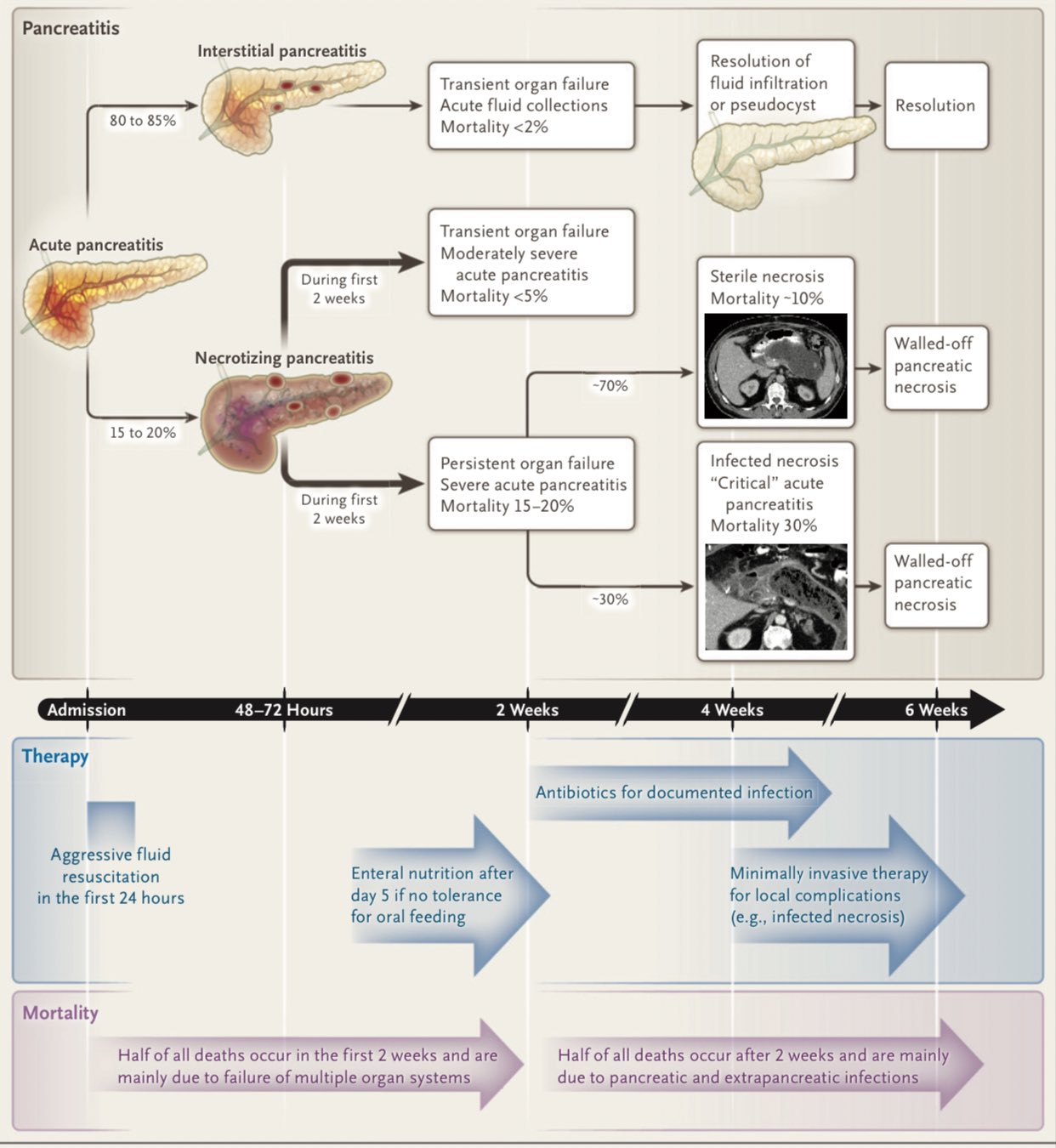Makindo Medical Notes"One small step for man, one large step for Makindo" |
|
|---|---|
| Download all this content in the Apps now Android App and Apple iPhone/Pad App | |
| MEDICAL DISCLAIMER: The contents are under continuing development and improvements and despite all efforts may contain errors of omission or fact. This is not to be used for the assessment, diagnosis, or management of patients. It should not be regarded as medical advice by healthcare workers or laypeople. It is for educational purposes only. Please adhere to your local protocols. Use the BNF for drug information. If you are unwell please seek urgent healthcare advice. If you do not accept this then please do not use the website. Makindo Ltd. |
Acute Pancreatitis
-
| About | Anaesthetics and Critical Care | Anatomy | Biochemistry | Cardiology | Clinical Cases | CompSci | Crib | Dermatology | Differentials | Drugs | ENT | Electrocardiogram | Embryology | Emergency Medicine | Endocrinology | Ethics | Foundation Doctors | Gastroenterology | General Information | General Practice | Genetics | Geriatric Medicine | Guidelines | Haematology | Hepatology | Immunology | Infectious Diseases | Infographic | Investigations | Lists | Microbiology | Miscellaneous | Nephrology | Neuroanatomy | Neurology | Nutrition | OSCE | Obstetrics Gynaecology | Oncology | Ophthalmology | Oral Medicine and Dentistry | Paediatrics | Palliative | Pathology | Pharmacology | Physiology | Procedures | Psychiatry | Radiology | Respiratory | Resuscitation | Rheumatology | Statistics and Research | Stroke | Surgery | Toxicology | Trauma and Orthopaedics | Twitter | Urology
Related Subjects: | Acute Cholecystitis | Acute Appendicitis | Chronic Peritonitis | Abdominal Aortic Aneurysm | Ectopic Pregnancy | Acute Cholangitis | Acute Abdominal Pain/Peritonitis | Assessing Abdominal Pain | Penetrating Abdominal Trauma | Acute Pancreatitis | Acute Diverticulitis
🧪 Lipase vs Amylase: Lipase is more useful than amylase as it is equally sensitive but more specific, and it remains elevated for longer. - ⏳ Lipase half-life: 8–14 days (vs 3–5 days for amylase). - 🚫 Lipase levels do not correlate with severity. - ✅ Particularly useful in delayed presentation of acute pancreatitis.
| ⚡ Initial Management of Acute Pancreatitis |
|---|
|
ℹ️ About
- 📉 Poor correlation between amylase level and severity.
- 🔥 Acute inflammation releases amylase, lipase, trypsin → autodigestion.
- ⚠️ Significant morbidity & mortality; may trigger SIRS and multi-organ failure.
- 📈 Incidence rising due to ↑ alcohol use & improved detection.
🎯 Causes
- 🪨 Gallstones (most common UK)
- 🍷 Alcohol
- 🧬 Pancreatic cancer, post-ERCP
- 📈 Hypertriglyceridaemia, hyperparathyroidism
- 💊 Drugs: steroids, thiazides, azathioprine, sulphonamides, fibrates, statins, ART drugs, valproate, cisplatin, erythromycin
- 🦟 Infections: HIV, CMV, EBV
- 🪲 Trauma, snake bite (rare)
🩺 Diagnosis (need 2 of 3)
- Severe epigastric pain radiating to back
- ↑↑ Amylase or Lipase (>3 × ULN)
- Imaging (USS/CT/MRI) consistent with pancreatitis

🧬 Aetiology / Pathophysiology
- Premature activation of pancreatic enzymes (trypsin, lipase, amylase) → autodigestion → fat necrosis, haemorrhage, inflammation → SIRS.
🩹 Clinical Features
- 🔥 Severe epigastric pain radiating to back, relieved by sitting forward
- 🤢 Nausea, vomiting
- 📉 Shock: tachycardia, hypotension, fever
- ⚠️ Grey Turner’s sign (flank bruising), Cullen’s sign (periumbilical bruising)
📊 Prognosis – Ranson’s Criteria
- At admission: Age >55, WCC >16,000, Glucose >11, LDH >350, AST >600
- At 48h: Hct fall >10%, Ca²⁺ <2, PaO₂ <8 kPa, BE < -4, Urea rise >1.8, Fluid needs >6L
📉 Mortality by Criteria
- 0–2: <5%
- 3–4: 20%
- 5–6: 40%
- 7–8: ≈100%
🔬 Investigations
- FBC, U&E, Ca²⁺, LFTs, LDH, Albumin, CRP, ABG
- Lipids (↑ triglycerides)
- Amylase (↑ but non-specific); Lipase (↑, more specific)
- USS: within 24 hrs for gallstones
- CT: within 7–10 days for severe cases, contrast-enhanced
- ERCP: if gallstone pancreatitis + cholangitis or obstruction
⚠️ Complications
- 🫀 Local: necrosis, pseudocyst, abscess
- 🫁 Systemic: ARDS, sepsis, renal failure, hypocalcaemia
- ➡️ Chronic pancreatitis if recurrent
💊 Ongoing Management
- 🔄 ABC resuscitation, IV fluids, catheter
- 💊 Analgesia (opioids), antiemetics
- 🥤 NBM initially; enteral feeding if prolonged
- 🧪 Antibiotics only if proven infection
- 🩻 ERCP + sphincterotomy within 72 hrs if gallstone pancreatitis
- 🔪 Necrosectomy for infected necrosis/abscess
- 🏥 HDU/ICU if organ dysfunction
🩺 Case 1 — Gallstone Pancreatitis
A 52-year-old woman presents with sudden severe epigastric pain radiating to the back, nausea, and vomiting. She has a history of gallstones. Labs: amylase 900 U/L, lipase elevated, ALT high. USS shows gallstones without duct dilatation. Management: 🏥 Admit, IV fluids, analgesia, antiemetics, and monitor for systemic complications. ERCP if cholangitis or obstructive jaundice. Definitive management = laparoscopic cholecystectomy. Avoid: ❌ Routine prophylactic antibiotics; avoid oral intake until pain and vomiting controlled.
🩺 Case 2 — Alcohol-Related Pancreatitis with Pseudocyst
A 45-year-old man with chronic alcohol use presents with acute epigastric pain and vomiting. He is managed supportively but continues to have persistent abdominal fullness 4 weeks later. CT abdomen shows a 6 cm pancreatic pseudocyst. Management: 💊 Supportive care during acute phase (fluids, analgesia, electrolyte balance). Large or symptomatic pseudocyst → endoscopic or surgical drainage. Refer to alcohol services. Avoid: ❌ Draining a pseudocyst too early (<4 weeks) as the wall may not be mature; avoid NSAIDs in renal impairment from pancreatitis.
🩺 Case 3 — Severe Pancreatitis with Necrosis
A 63-year-old man presents with severe pancreatitis due to hypertriglyceridaemia. He develops hypotension, tachycardia, hypoxia, and rising CRP. CT scan shows necrotising pancreatitis with areas of non-enhancing pancreas. Management: 🚑 Admit to HDU/ICU, aggressive IV fluid resuscitation, oxygen support, nutritional support (NG feeding). If infected necrosis, consider broad-spectrum antibiotics and surgical or radiological debridement. Avoid: ❌ Prophylactic antibiotics for sterile necrosis; avoid morphine derivatives that may cause sphincter of Oddi spasm (pethidine historically preferred, though in practice morphine still used with care).